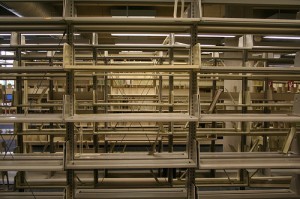 What happens to Lean strategy in the event of an inventory shortage?
What happens to Lean strategy in the event of an inventory shortage?
Companies that have too little product on hand also experience waste.
Specialist retailer Lululemon shaved inventory margins too close. As a result, customers and investors are disappointed and the company has been forced to waste money on shipping products by air rather than by sea.
A strategy of lean inventories in stores became problematic when supplier issues and a website migration caused widespread dissatisfaction with a lack of inventory both in stores and online.
As the Lululemon case demonstrates, perhaps the greatest peril of understocking lies in the unsustainable additional costs imposed when a company must scramble to restock empty shelves.
Whether it's shipping expedition or overtime payments to workers, any disruption in your supply chain that creates a "rush job" will cost you. This waste is avoidable through proper planning and product flow.
Another risk, more subtle but equally perilous, is that of overwork. Lean management identifies overwork as wasteful for good reason. It contributes to high turnover (possibly the most wasteful of all personnel programs) and leads to accidents if tired workers make mistakes. If a company runs low on inventory and must increase production to fix the oversight, laborers will be overworked.
Lastly, understocking creates waste in that it needlessly damages customer perceptions, forcing additional work and additional costs just to regain your previous perception.
How would you feel about a company whose products were unavailable when your car was broken down? If the part you need is nowhere to be found from your preferred manufacturer, brand loyalty is likely to fall by the wayside as you scramble to repair your vehicle.
Lean management is about customer defined value, and a basic component of value is availability.
So, what is a Lean manager to do? How can one stock just enough products without leaving shelves bare or products gathering dust?
There is no single perfect solution, but the following best practices will help:
 If you practice lean management, you can rattle off the original seven wastes, described by Taiichi Ohno, at a moment's notice.
If you practice lean management, you can rattle off the original seven wastes, described by Taiichi Ohno, at a moment's notice.
In fact, you likely know of at least two additional wastes you would add to the master list.
But what about colleagues unfamiliar with lean management?
If lean managers are a minority when decisions are made within your organization, it may be difficult to argue against these wastes, also known as muda.
Although most people understand defects are wasteful, they may not understand exactly how much productivity is affected by a small increase in defects.
Similarly, knowing that overproduction is less than ideal does not equate to comprehensive understanding of its supply chain effects.
The following suggestions will help you demonstrate or explain muda to colleagues who have not yet "bought in" to lean manufacturing. (more…)
